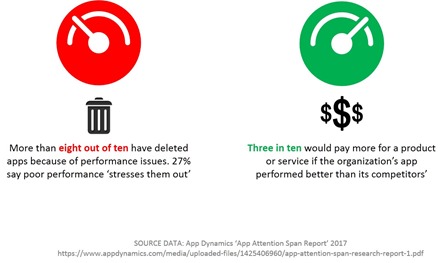Vos applications stressent-elles les utilisateurs avec de mauvaises performances ?
Une enquête récente révèle que 27 % des utilisateurs affirment que les mauvaises performances sont non seulement frustrantes, mais aussi stressantes.
Il y a quelques années, le comédien Louis CK a prononcé ce qui est aujourd’hui une complainte classique (pour certains d’entre nous, en tout cas), qui a été surnommée « Tout est incroyable et personne n’est heureux ». Si vous l'avez vu, soyez indulgents avec moi pour ceux qui ne l'ont pas vu. Dans ce film, Louis observe ceux qui l'entourent devenir frustrés par l'utilisation de la technologie dans un avion, et souligne l'amusante réalité de notre impatience face à la lenteur du Wi-Fi à bord lorsque nous volons dans les airs – un exploit d'ingénierie incroyable en premier lieu.
Cette lamentation est peut-être celle que ceux d’entre nous qui ont fait leurs armes sur des connexions par ligne commutée et des pages Web anormalement lentes peuvent comprendre. Il est fascinant de voir les « natifs du numérique » se contorsionner d’angoisse lorsqu’une application ou une page Web prend plus qu’un clin d’œil (environ 400 ms) à charger. Peut-être que la patience des utilisateurs les plus expérimentés vient de nos souffrances causées par des téléchargements de plusieurs heures de Slackware Red Hat qui ont monopolisé nos lignes téléphoniques et nos ordinateurs, pour être ensuite corrompus cinq minutes après la fin par des déchets numériques injectés par l'attente d'un appel grâce à un énième appel de télémarketing urgent.
Les jeunes d’aujourd’hui n’ont aucune idée de la chance qu’ils ont. Internet (et la technologie en général) est vraiment incroyable. Et pourtant, personne n’est heureux. Il s’avère qu’ils ne sont pas seulement malheureux, ils sont stressés .
Mais nous ne pouvons pas revenir en arrière (et honnêtement, qui le souhaite vraiment ?), donc tout ce que nous pouvons faire, c’est accepter le monde tel qu’il est, et non tel qu’il était ou tel que nous voudrions qu’il soit. Et cela signifie des utilisateurs de plus en plus sensibles aux variations de performances.
Ainsi, lorsqu’un rapport comme celui d’AppDynamics arrive, détaillant l’impact dévastateur d’une mauvaise performance, nous devrions y prêter attention. Parce que les mauvaises performances constituent un problème grave qui peut avoir un impact considérable sur votre capacité à profiter d’une part de l’économie mondiale des applications, désormais estimée à plus de 6 000 milliards de dollars en 2021.

L’impact potentiel n’est pas négligeable. Au contraire, il s’avère que les utilisateurs d’aujourd’hui sont plus fidèles à une application qu’à une marque. On pourrait alors conclure que dans l’économie des applications, votre application est votre marque, pour le meilleur ou pour le pire.
Le pire, en fait, est bien plus grave que ce à quoi on pourrait s’attendre. Les mauvaises performances non seulement frustrent les utilisateurs, mais les stressent également.
Étant donné que beaucoup d’entre nous dépendent d’applications – mobiles ou non – pour effectuer une centaine de tâches différentes au cours d’une journée de travail typique, il ne s’agit pas uniquement de vos applications externes. Il s’agit à la fois d’applications conçues pour le profit et la productivité.
La vérité est que dans l’économie numérique, les applications sont l’occasion de développer le produit intérieur brut (PIB) des entreprises (PIB) avec une productivité améliorée et des profits accrus grâce à la commodité. Mais de mauvaises performances peuvent mettre un terme brutal à cette croissance.
Lorsque 8 utilisateurs sur dix ont SUPPRIMÉ une application en raison de problèmes de performances, vous avez perdu une opportunité. La triste réalité est que, d’après ce rapport, ils sont probablement déjà allés voir un concurrent.
La bonne nouvelle est qu’il existe une variété de services d’application conçus pour améliorer les performances. Et les organisations les utilisent.
LES SERVICES D'APPLICATION QUE LES ENTREPRISES UTILISENT POUR AMÉLIORER LES PERFORMANCES
Le problème est que vous n’avez pas toujours (rarement, en fait) un contrôle total sur les performances de votre application. Il y a le dernier kilomètre, ce tronçon sinueux de câble entre vous et l’utilisateur. Il y a la plateforme d’application elle-même, qui peut ou non déjà être peaufinée et ajustée autant qu’elle peut l’être. Si c’est dans le cloud public, vous n’avez aucun contrôle sur le réseau lui-même. Et puis il y a l’application. Choix de la langue, connectivité de la base de données, logique. Les facteurs qui contribuent à une mauvaise performance sont nombreux et ne sont pas toujours sous le contrôle de quiconque. Les services d'application, qui se situent en amont du chemin des données, sont en mesure de fournir un excellent contrepoids aux problèmes qui entravent les performances des applications et, dans de nombreux cas, de leur donner une longueur d'avance pour fonctionner mieux que vous ne l'auriez espéré.
Des techniques telles que la compression et l’accélération (minification, optimisation d’image, etc.) améliorent les performances en manipulant le contenu pour le diffuser plus rapidement, à l’intérieur comme à l’extérieur de l’organisation. Les services axés sur les protocoles tels que HTTP2 et « HTTP rapide » visent à éliminer les aspects gênants des protocoles textuels qui empêchent la diffusion plus rapide des applications. Bien que l’utilisation de HTTP2 reste lente, nous avons constaté dans notre enquête sur l’état de la distribution des application 2017 qu’un pourcentage important d’organisations (16 %) prévoyaient de déployer HTTP2. D’autres services liés aux performances ont obtenu de bons résultats, rivalisant avec les performances liées à la sécurité pour le titre de « services les plus susceptibles d’être déployés au cours de l’année prochaine ».
Le déchargement SSL et le multiplexage TCP signifient que les serveurs se concentrent sur la diffusion de contenu, sans effectuer d'acrobaties cryptographiques et liées à la connexion à chaque demande et réponse, une tâche de plus en plus lourde lors de la diffusion d'applications construites à partir de centaines d'appels d'API.
Les services d’application fournissent un ensemble robuste d’options pour améliorer les performances des applications, dans le cloud ou dans le centre de données. Leur objectif est uniquement de savoir comment rendre les applications plus rapides, quel que soit leur emplacement ou leur construction.
Les performances ont toujours été importantes, mais elles n’ont jamais été aussi cruciales qu’elles le deviennent dans l’économie des applications. Avec une tolérance plus faible aux mauvaises performances (on pourrait même suggérer que les utilisateurs sont très sensibles à la gigue de nos jours), il est plus important que jamais de profiter de toutes les astuces de votre boîte à outils pour vous assurer que votre application va suffisamment vite pour satisfaire même les utilisateurs les plus exigeants.
Si tu as besoin d’un sujet de test pour ça, je te louerai mon enfant de 9 ans. Si vous parvenez à satisfaire son doigt nerveux, vous avez un gagnant.

